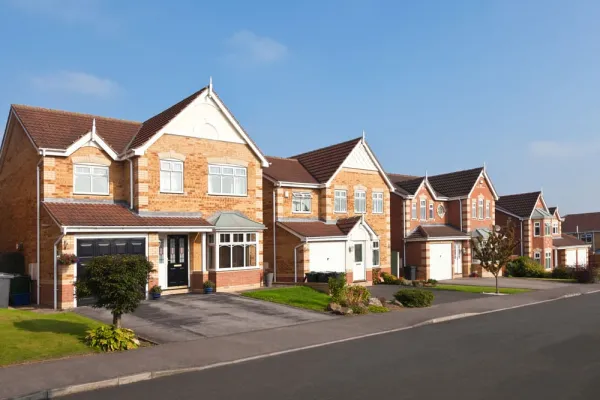The gap between average income and average property prices is widening.
(Some even believe this might cause a UK property market crash.)
Fortunately, affordable housing exists. You’ll often find these properties on new build estates.
But what causes these homes to be built? And how can you find out if you’re eligible to move into one?
Read our blog below for the answers to these questions and more.
What is a new build estate?
Every year, new build estates are constructed in the United Kingdom. They are usually built by:
- Private developers
- Housing associations
- Local councils.
A new build estate is a group of properties that have never been lived in before.
These have only been constructed in the past few months or years when they first enter the market.
These estates aim to meet the rising need for new houses in the UK. Each one is clean, newly designed, and will form part of a new local community.
If these houses sell or rent at an affordable price, it can be attractive for nearby residents.
What is affordable housing on a new build estate?
When a new build estate is constructed, some properties are allocated by the developer as ‘affordable housing’.
These properties are sold or let out below the market rate to people who meet specific criteria.
The UK government aims for at least 10% of new build developments to be designated as affordable housing.
This percentage can increase in some locations, with local authorities setting higher targets.
This is particularly common in London, where affordable housing is scarce.
Several UK government-backed initiatives help pay for these, which we’ve summarised in the section below. Each one has its criteria for eligibility.
Examples of government-backed affordable housing initiatives
First Homes
‘First Homes’ is one of the leading affordable housing initiatives. The First Homes scheme offers local first-time buyers and key workers a 30 – 50% discount on new-build homes.
The discount is passed to the next buyer when you sell the house.
Shared Ownership
‘Shared Ownership’ is another well-known scheme.
This is when you buy a percentage of the house and thus make mortgage repayments on it while making rental payments on the part that you don’t own.
It’s then possible to increase your home ownership share as time passes, known as ‘staircasing’.
Rent to buy
‘Rent to Buy’ offers a property at 20% below market rate.
Your initial tenancy agreement will be for up to 2 years, during which you should save up for your deposit on the discounted house.
After that, if you need more time to save up for your deposit, your landlord may agree to extend your tenancy.
Social rent
Not all schemes are geared towards buying a new build house.
The ‘Social Rent’ initiative charges a property at 50% of the typical market rate, while ‘Affordable Rent’ does it at 80%.
Each has its own eligibility requirements, as it’s aimed at the lowest-earning people in the country. You apply through your local council.
How to apply for affordable housing on a new build estate
Information about local affordable housing is usually available by contacting your nearby council.
You should speak to house associations in your area to see if they have any schemes, too.
These organisations can give you guidance on how to apply.
It usually involves filling out a form that gives details on your:
- Age
- Current living situation
- Employment
- Income
And more.
You’ll need to be open about all this information.
Am I applicable for affordable housing on a new build estate?
The government website explains eligibility for each initiative.
You should search for the applicable scheme to see whether you apply. Many of these initiatives have similar criteria, such as:
- Aged over 18
- Not earning more than a certain income
- Living in the area already
- Being able to afford the reduced rate.
Do your research via the government website or speak to the developer or local council.
They can usually point you in the right direction, including the steps you must complete to apply.
Is the amount of affordable housing going up or down?
Figures from the House of Commons address this. The proportion of housing for affordable or social rent has fallen from around 20% in 2000 to 16% in 2023.
This has received criticism from some parts of society.
The July 2020 report of the Housing, Communities and Local Government Committee commented on this. They said “high cost of land is the single biggest barrier councils face in getting social housing built”.
The government now plans to introduce new ways to help local councils buy cheaper land to build affordable housing.
















